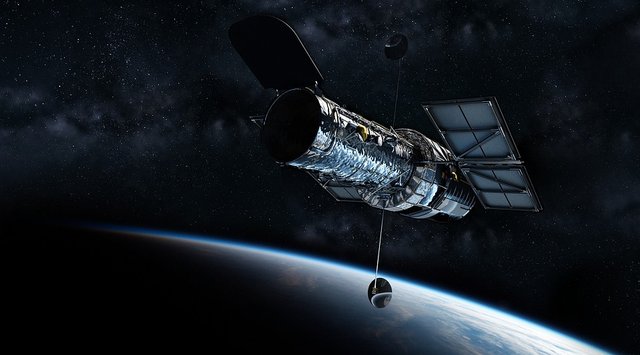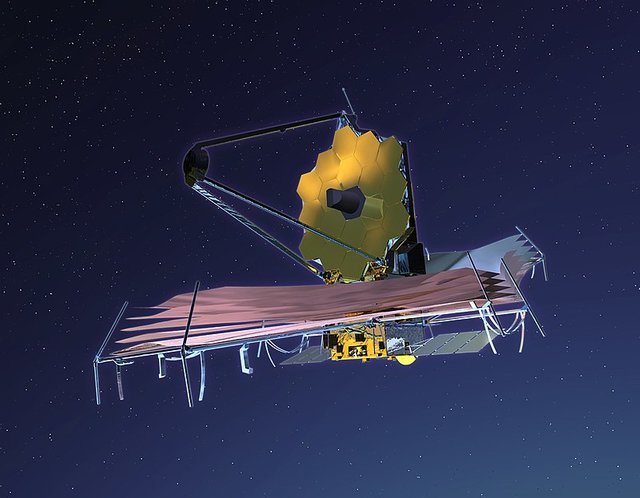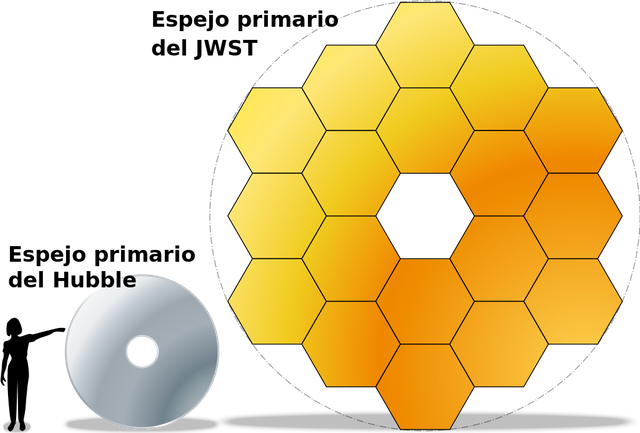Differences between the Hubble and James Webb Telescopes
The recent space race closed last year with the successful launch of the James Webb telescope, which promises to send us from orbit fabulous images and discoveries far more amazing than its predecessor telescope, Hubble.

Illustration of the Hubble space telescope. Source: pixabay.com.
But the footprints left by Hubble will undoubtedly be difficult to surpass, after three decades in space, this amazing space exploration tool has provided incredible images, such as the nebula of the pillars of creation, unprecedented details of Saturn's rings or the Milky Way, and not only images, but it has helped in the investigation and verification of the existence of supermassive black holes, that there are nurseries of new stars and that the universe is expanding and accelerating, so with so many discoveries it will be a challenge for the new telescope to surpass its predecessor.

Illustration of the James Webb Space Telescope. Source: wikipedia.com.
But is another telescope really necessary? Let's see how these two extraordinary pieces of space engineering differ.
Size
For any telescope the most important component is its mirror, and the Hubble telescope has an impressive 2.4 meter panel, but the James Webb has been equipped with an imposing 6.5 meter super mirror made of 18 pieces of gold-coated beryllium; this means that the James Webb will be able to study the cosmos in more detail, the Webb will be able to focus on a fairly small area of space for days trying to detect light that has been traveling through space for more than 13.5 billion years.

Comparison between the primary mirrors of the two telescopes. Source: wikipedia.com.
In addition to its imposing mirror, the differences in dimensions between the two are also considerable. At 21 meters long and 14 meters wide, the James Webb telescope is almost twice the size of the Hubble telescope, which is 13 meters long. And despite being twice as large, the James Webb weighs only half as much as the Hubble.
Field of view
Although the field of view on both telescopes is small, and so one image is actually composed of several snapshots, the James Webb camera's field of view will be considerably larger than Hubble's, and it is also significantly better.
Orbit
Another important difference between the two telescopes is their position with respect to the earth, while the Hubble telescope orbits almost 600 km above our surface, the James Webb will be located at 1.5 thousand kilometers.

The James Webb will orbit 1.5 million kilometers from Earth at what is called the second Lagrange point or L2. Source: NASA.
Wavelengths
The Hubble telescope observes the universe mainly by capturing light in the visible and ultraviolet wavelengths, while the James Webb telescope will observe the universe mainly by capturing light in the infrared range. This will allow James Webb to determine what is going on behind clouds of dust and gas, and also to observe what the universe was like 13.5 billion years ago, which is a billion years older than Hubble.
Lifetime
By placing an instrument so far away from the Earth, the possibility of a manned mission to repair any malfunction of the James Webb telescope is ruled out, something that has already been done with the Hubble, which is why each instrument of the Webb has been tested to leave no room for errors. But this undoubtedly shortens the lifetime of the Webb, while Hubble is already just over 30 years in service the James Webb is expected to operate for 5 or at most 10 years.
The James Webb telescope is an extraordinary machine that will literally allow us to look into the past, capturing the light that takes 13.5 billion years to reach the earth is equivalent to looking at what the first stars were like after the Big Bang, something about which very little is known, only what has been theorized based on computer models.
The light from these distant stars spreads out thanks to the expansion of the universe and moves toward the infrared range of the spectrum, a factor that has been limiting for Hubble, since it cannot focus enough in the infrared spectrum, where the signals from those first stars are found, which would tell us about the end of the dark ages and the beginning of everything.
There is no doubt that the Hubble space telescope, launched in 1990, is a pioneering instrument, it has given us incredible photographs of our universe, but the power of a telescope increases with the diameter of its mirror, and that is where the James Webb telescope comes in to give us a greater range of vision.
Thanks for coming by to read friends, I hope you liked the information. See you next time.

Nice work! You just got yourself a $2.07 upvote. Enjoy! Check us out at acom.uno or swing by for a chat at ACOM Discord
Thank you for sharing this amazing knowledge.
Thanks to you for stopping by to read.
Hello @emiliomoron, happy new year..!
What interesting information, in fact I did not remember the recent existence of the James Webb telescope, I am already looking forward to seeing the new images captured from space, I even have in mind to buy a small telescope to place on the roof just to observe the stars, it would only serve to This, I do not regularly follow the news of new sightings from space.
Hi @tocho2, the new telescope was launched on December 25, it is still on its way to orbit but certainly we all want to see its first images. And depending on the scope range of the telescope you want you might be able to observe the details of the moon. Greetings!